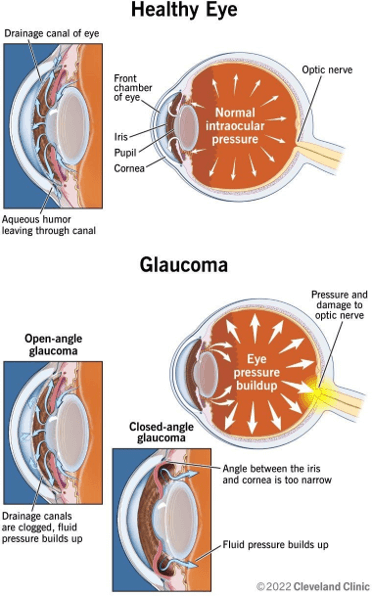The practical nurse (PN) is reviewing a client's recent ophthalmic screening test results. Findings of optic neuropathy, loss of peripheral vision, and increased intraocular pressure are consistent with which medical condition?
Glaucoma
Macular edema.
Cataract
Diabetic retinopathy
The Correct Answer is A
Glaucoma is a group of eye diseases that damage the optic nerve and cause vision loss. It is often associated with increased intraocular pressure, which can compress the nerve fibers and reduce blood flow to the retina. The most common type of glaucoma, open-angle glaucoma, causes gradual loss of peripheral vision.
The other options are not correct because:
- Macular edema is a condition that causes swelling and fluid accumulation in the macula, the central part of the retina that is responsible for sharp and detailed vision. It can cause blurred or distorted vision, but it does not affect the optic nerve or the peripheral vision.
- Cataract is a condition that causes clouding of the lens, which is the transparent structure that focuses light onto the retina. It can cause blurred, dim, or yellowed vision, but it does not affect the optic nerve or the intraocular pressure.
- Diabetic retinopathy is a complication of diabetes that damages the blood vessels in the retina and causes bleeding, leakage, or scarring. It can cause blurred, fluctuating, or darkened vision, but it does not affect the optic nerve or the intraocular pressure.

Nursing Test Bank
Naxlex Comprehensive Predictor Exams
Related Questions
Correct Answer is C
Explanation
The correct answer is choice C. Red welts widespread over the chest.
Choice A rationale:
Ulceration on the corner of the upper lip does not indicate a need for loratadine administration. Loratadine is an antihistamine commonly used to relieve symptoms of allergies such as sneezing, runny nose, and itchy or watery eyes. Ulceration on the lip is not associated with an allergic reaction.
Choice B rationale:
Ecchymosis and petechiae on the legs are not related to the need for loratadine. These findings suggest potential bleeding or clotting disorders, and loratadine does not address such issues.
Choice C rationale:
Red welts widespread over the chest are indicative of hives (urticaria), which are often caused by allergic reactions. Loratadine can help alleviate the symptoms of hives by blocking histamine release, making it an appropriate choice for this condition.
Choice D rationale:
Red papules and pustules on the face are unlikely to be treated with loratadine. These skin manifestations may be related to various dermatological conditions, but not necessarily allergic reactions that loratadine is primarily used to manage.
Correct Answer is D
Explanation
The correct answer is choice D. Don non-sterile gloves when performing direct care.
Choice A rationale:
Placing a surgical mask on the client during transport is not necessary for preventing the spread of Clostridium difficile. C. difficile is primarily spread through contact with contaminated surfaces and not through airborne transmission.
Choice B rationale:
Keeping the door closed to the client’s room at all times is not required for C. difficile infection. The focus should be on contact precautions rather than airborne precautions.
Choice C rationale:
Wearing a particulate respirator mask is not needed for C. difficile, as it is not an airborne pathogen. Standard contact precautions are sufficient.
Choice D rationale:
Donning non-sterile gloves when performing direct care is essential to prevent the spread of C. difficile. The spores can be transmitted via the hands of healthcare workers, so wearing gloves helps to minimize this risk.
Whether you are a student looking to ace your exams or a practicing nurse seeking to enhance your expertise , our nursing education contents will empower you with the confidence and competence to make a difference in the lives of patients and become a respected leader in the healthcare field.
Visit Naxlex, invest in your future and unlock endless possibilities with our unparalleled nursing education contents today
Report Wrong Answer on the Current Question
Do you disagree with the answer? If yes, what is your expected answer? Explain.
Kindly be descriptive with the issue you are facing.
